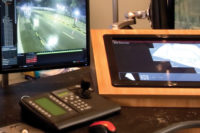
On Nov. 20, before the opening of ISC East, N.Y.-based integrator Total Recall Corp. along with nine vendor partners led a tour of the new security system and command center it designed and installed to secure the Statue of Liberty National Monument and Liberty Island.
The Statue of Liberty reopened to the public on July 4, 2013, following eight months of renovation and repairs due to the devastation caused by Hurricane Sandy. As part of the refurbishment, Total Recall reached out to the U.S. Park Police, National Park Service (NPS) and the Department of Interior (DOI) with a state-of-the-art surveillance system proposal that would be designed, installed and maintained as a donation by the company.
Jordan Heilweil, president of Total Recall worked closely with Captain Greg Norman of the U.S. Park Police and others to redesign the Statue’s surveillance and security system from top to bottom by bringing together nine technology vendors. Today’s IP-based, all-digital security solution enhances public safety and improves operational efficiencies.
In this new upgrade, Total Recall and the technology team migrated the Statue from analog CCTV to the latest in digital video technology to enable the park to cover areas with high-quality video surveillance that they could not reach before. The team constructed an intelligent and ultramodern command center three times the size of the previous center to help the NPS and U.S. Park Police do their jobs more effectively.
The command center used to be in Liberty Island and was therefore vulnerable if a major security event were to take place at the monument. The new command center was moved off-site to a more advantageous position on Ellis Island.
Heiweil described his vendor partners in this project as the “Dream Team” for the unique expertise they brought to the solution.
Axis Communications provided a mix of nearly 160 IP cameras with HDTV quality, exceptional nighttime performance, powerful zoom, reliability and discreet appearance. Throughout the island, security devices are not hidden, so as to assure visitors the area is monitored, but Total Recall took special measures to ensure the devices do not distract from the main attraction. For example, the four PTZ cameras on each side of the monument’s base were painted to blend in.
BriefCam added its unique Video Synopsis software solution that enables law enforcement and security personnel to review hours of surveillance video in minutes. Each morning, the command center operators can review the entire night’s events captured on video in minutes rather than skipping around through hours of footage.
DragonWave supplied multi-gigabit packet microwave radios, delivering carrier-class transport for mission critical public safety communications.
Milestone Systems provided its open platform IP video management software that enables first responders to quickly search for incidents while pushing video to mobile devices.
Pivot3’s reliable digital storage and computer devices specifically designed for the video surveillance industry allows Park Police a storage capacity well beyond the industry standard, Norman said.
Proxim Wireless delivered high capacity, wide area wireless broadband utilizing WORP® technology in order to connect IP cameras in areas the previous system could not reach.
RGB Spectrum enabled multiple video feeds to be displayed on the massive video wall in the command center using its MediaWall 2900 Display Processor.
Scallop Imaging contributed perimeter security via its all solid-state M6-200 IP cameras with six megapixel, extreme low-light video and undistorted panoramic 200° FOV.
Winsted Corporation, delivered ergonomically designed command center consoles that allow operators to be as efficient and comfortable as possible in a high-stress environment.








